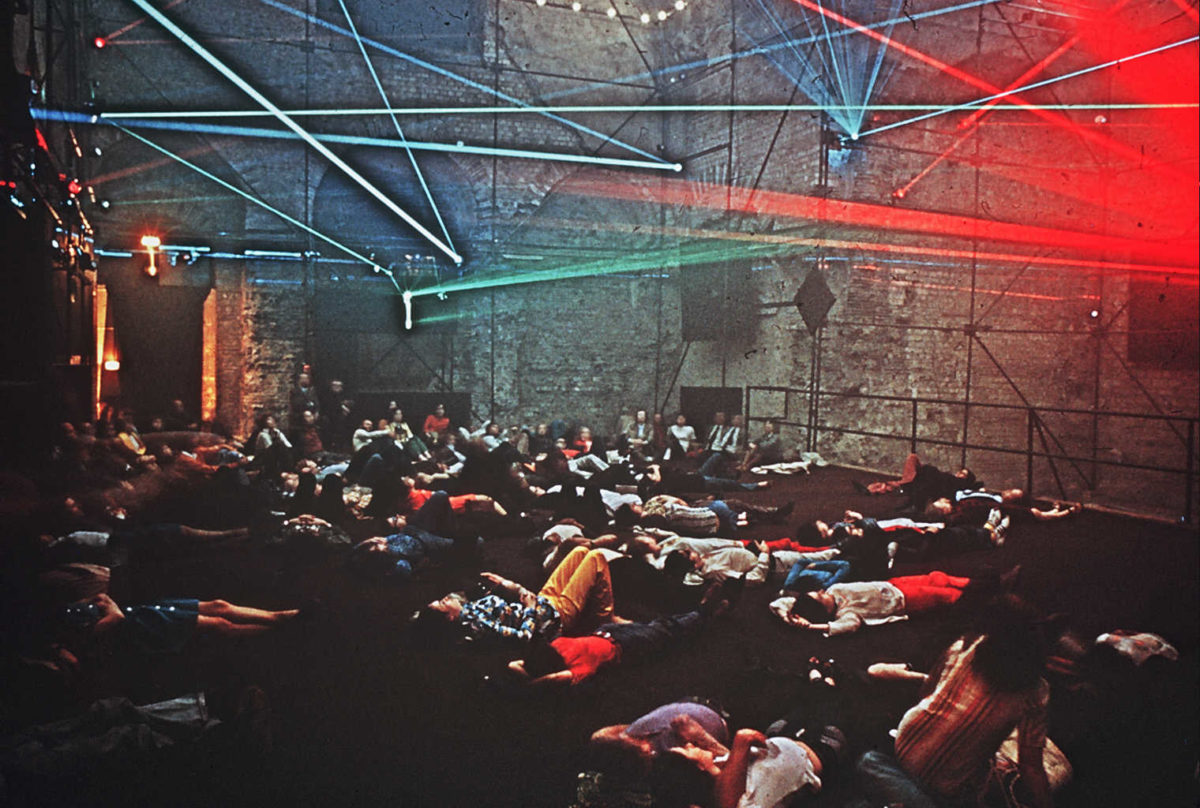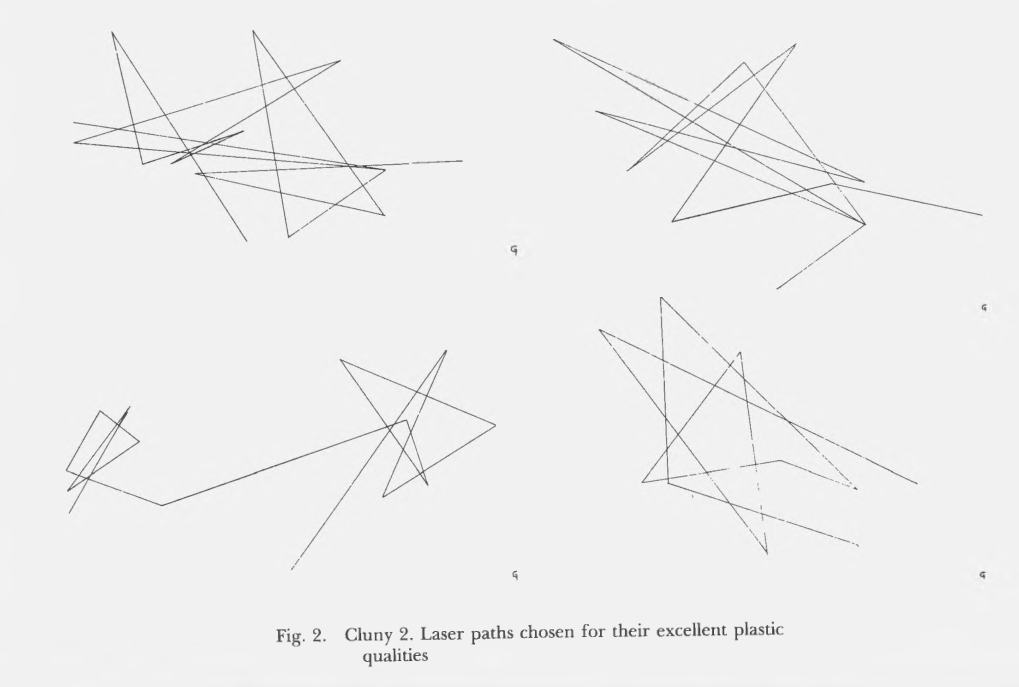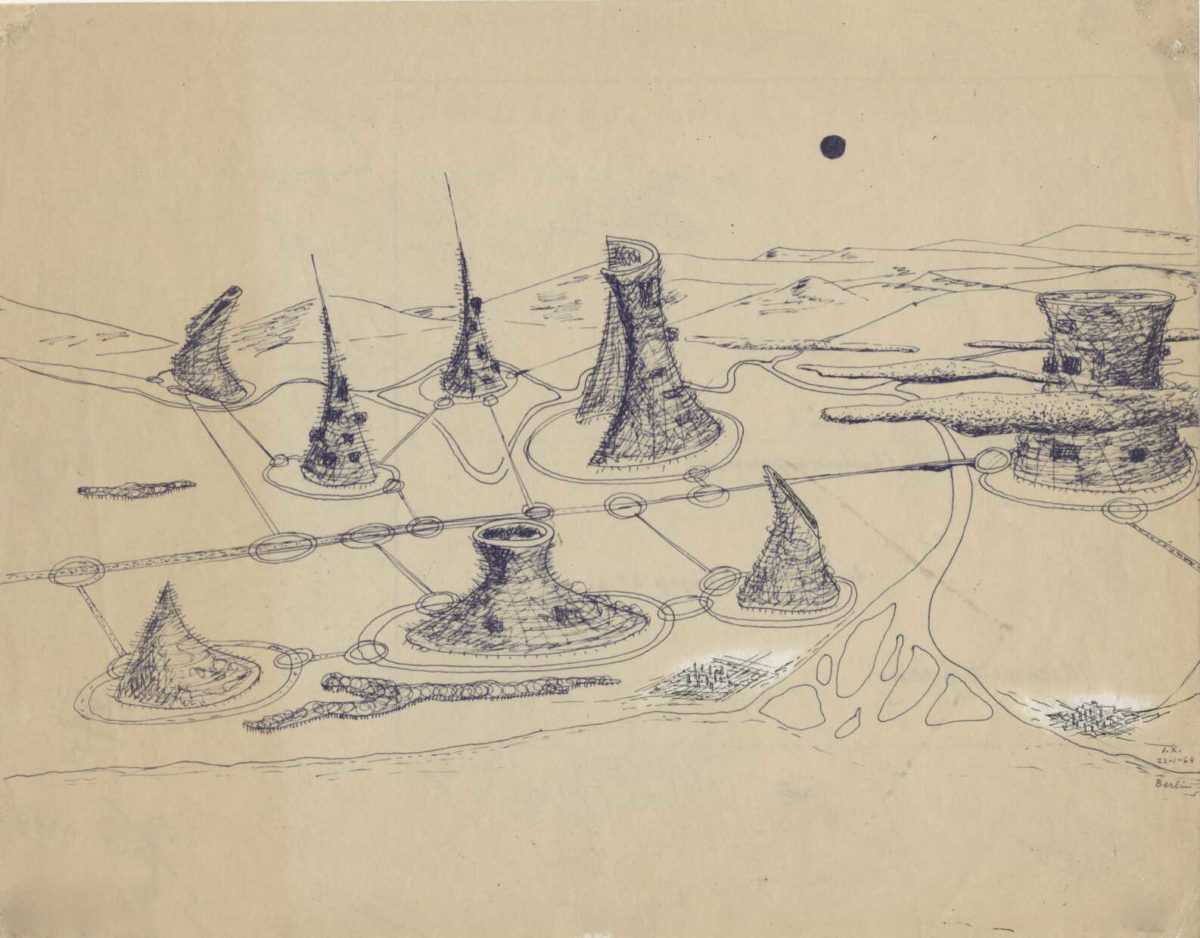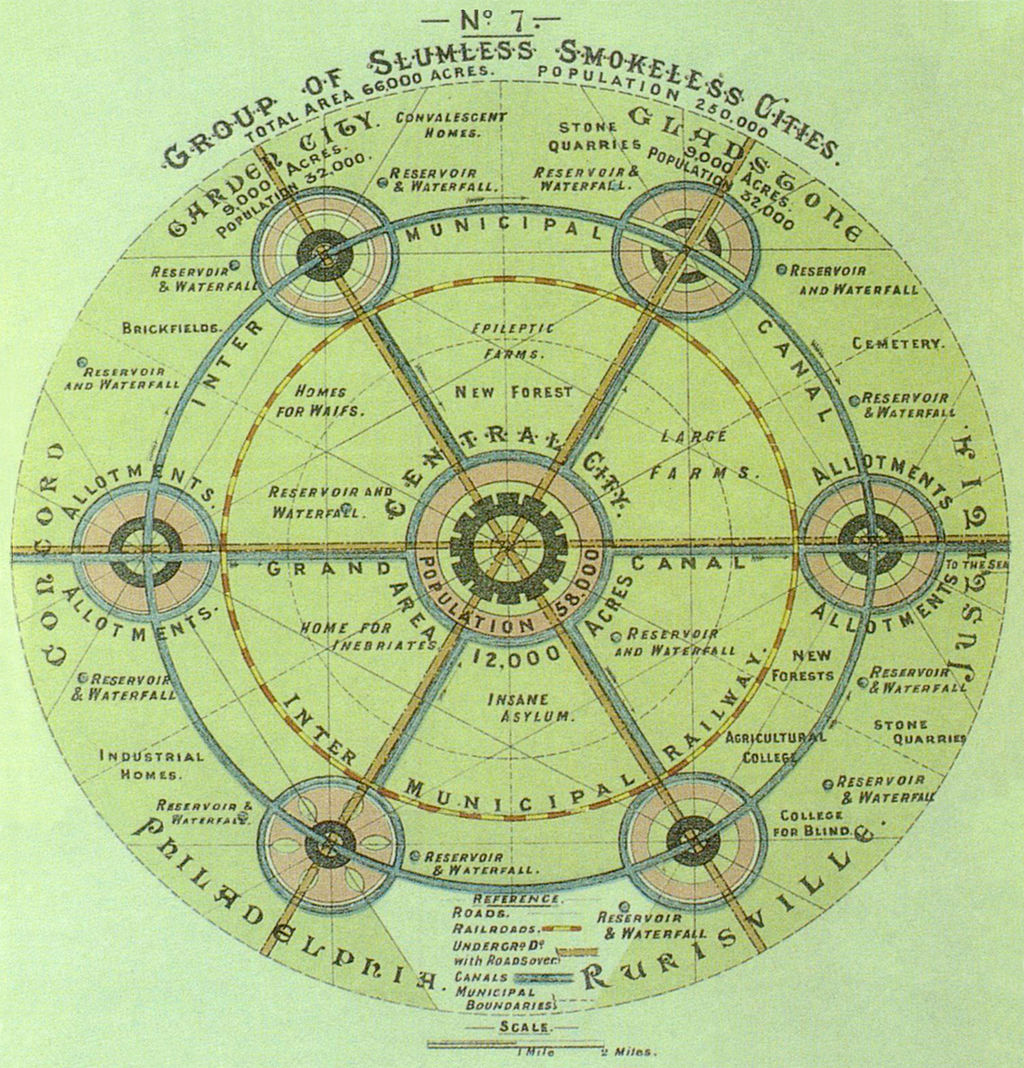created, & modified, =this.modified
rel: Musical, Sound Architecture Granular Synthesis
Why I’m reading
Musical, Sound Architecture came across this Art Alloy concept and found this, his thesis. Proposes free movement of thought, between arts and sciences.
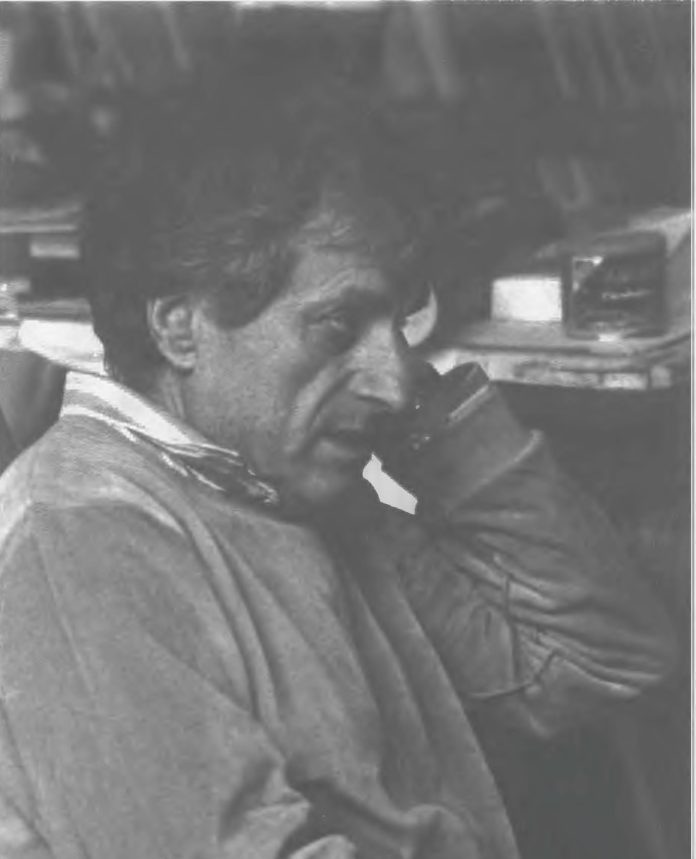
Preliminary Statement
The worlds of classical, contemporary, pop, folk, traditional, avant-garde, etc., music seem to form unities unto themselves; sometimes closed, sometimes intersecting. Not only do they present extraordinary deviations, rich in new creations, but also fossilizations, ruins, and wastes, all in continuous formations and transformations, much like clouds—so distinct yet so ephemeral.
Music is a sociocultural phenomenon, subordinate to a moment in history. But parts are more variable invariable that others, which form materials of hardness and consistency from epochs of civilizations, and interact with each other in self annihilating, benefiting, or otherwise influential ways.
The essence of materials is man’s intelligence in some what solidified. Music and the arts, are a materialization of intelligence. Intelligence is universal, but diversified by distinguishing talent.
Time has come to establish a new science of general morphology. The backdrop for this new science should be a condensation of intelligence (an abstract approach, free of anecdotes of senses and habits.)
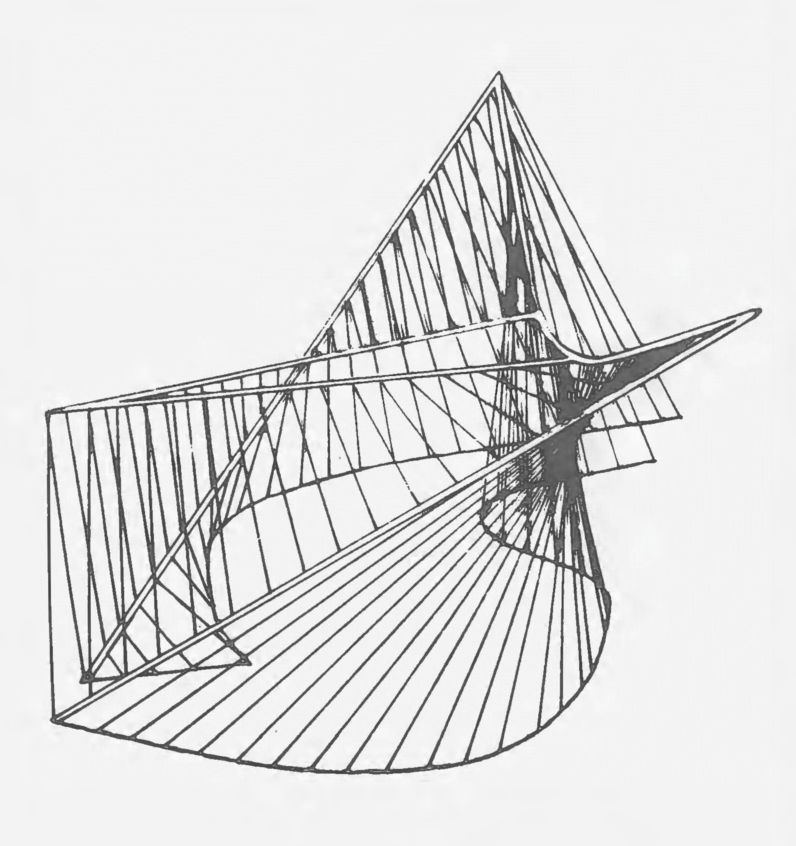
Art exists in 3 modes
- inference
- experimental – challenges or confirms theories created
- revelation – immediately occurring to someone ignorant of art, or practiced.
Art, while living the two dimensions of inference and experimentation, possesses this third and most mysterious dimension which permits art objects to escape any aesthetic science while still enjoying the caresses of inference and experimentation.
Visions:
This may seem utopian, and in fact it is, but only temporarily when viewed in the context of the immensity of time. On the contrary, what is not utopian but possible today is to cast luminous spiderwebs of colored laser beams like a giant polytope over cities and countrysides: the use of clouds as reflector screens, the use of artificial satellites as reflecting mirrors so that these “webs” rise in space and surround the earth with their phantasmagorical, moving geometries; joining the earth and the moon by filaments of light.
He refers to his works as answers to questions:
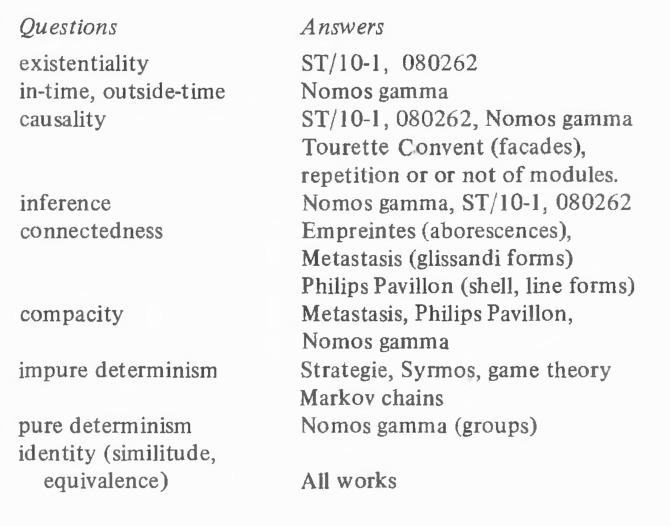 Oliver Revault D’Allonnes
Oliver Revault D’Allonnes
These “alloys” are indeed not without problems, for me at least. They are architectural and musical works, the polytopes, but also included is the theoretical work we have before our eyes.
The Polytope of Cluny – an automated light spectacle (3 laser beams and 600 electronic flashes) and sound spectacle (with original music for tape) – took place over several months in two versions (1972-72 and 1973-74) in the Roman baths of Cluny (Paris)
Xenakis to compose the music for a slide show on the theme of Crystals. Instead of a sequence of images and sounds, the composer proposes an “electronic sculpture that combines light, music and structure” with the following properties: around the central void created by the seven floors of the pavilion designed by Jean Faugeron, he forms five hyperbolic paraboloids made of steel cables on which 1200 electronic flashes are distributed and vary every 25th of a second (threshold of perception by the human eye). Once an hour, during eight minutes, the spectator perceives these movements of light in the center of the pavilion. He can, moreover, walk on the floors, go up and down and thus modify his point of view on the installation. After these eight minutes, everything returns to its natural state. The rhythm of the illumination of flashes is based on mathematical group structures. Xenakis also thought about the automation of the light show, with a control strip, which however requires human intervention.
Oliver Revault D’Allonnes questions the balance of art/science and which will be favored in the pairing. The free movement, an alloy, is a utopian thing which didn’t exist then.
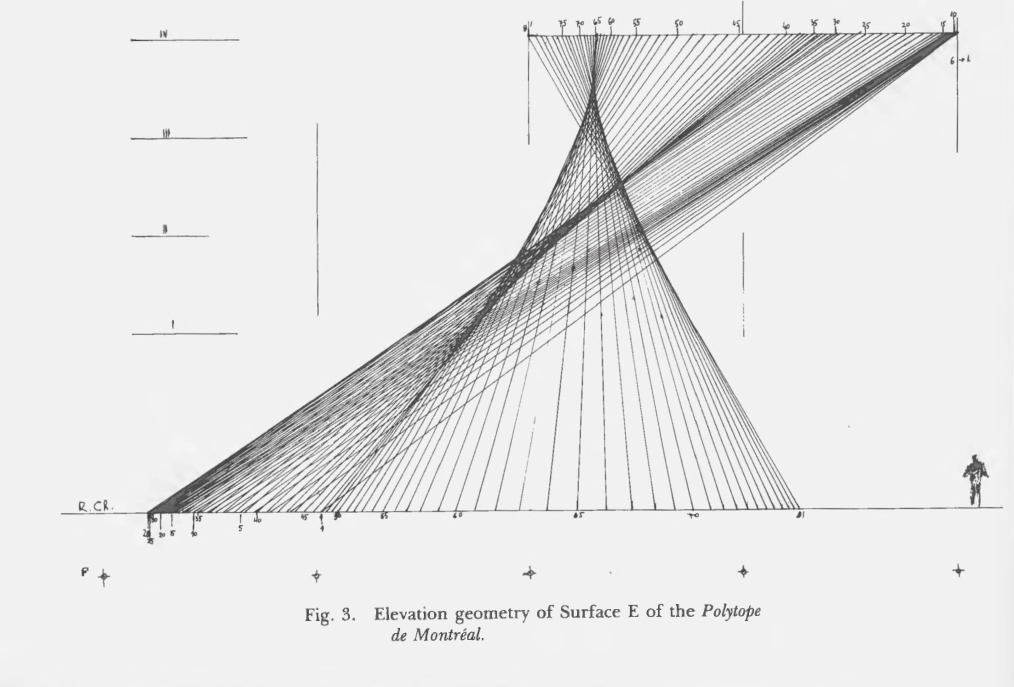 Iannis states:
Iannis states:
there is something else in music, in any music, even in the “ugliest” music. But, this “something” is neither distinguishable nor discernible; it is “unspeakable.” It’s the traits which are not yet describable. It is the art-object which must express them.
I believe the fundamental point of the Renaissance was its rediscovery of man’s uniqueness. Man is something unique, singular. There are not many men, there is but one. This man encompasses all thinking and acting possibilities, and consequently, the interpretation between the sciences and arts.
Oliver brings up a point on pedagogy - stating that neither innocently not by chance, pedagogy creates literati on one hand, scientists on the other.
Xenakis thinks it is primarily due to the time factor involved in specialization, but points to himself as someone who has gone past the superficial, researching into multiple fields. Mankind’s organization produces spiritual and intellectual invalids.
at the basis of art (and equally of science), there is this whole vision which can be called the vision of the twentieth century, which is a totality and which is hope, and finally which should be the hope of humanity.
Oliver Dialogue
In the beginning of music, before there were scales and modes and scale-constructs there were only tetrachords. Oliver questions why he stopped at scale material and not considered “cries” and exclamatory language – the perception and imitation of other sounds such as wind, water and birdsong.
Oliver also says that collections of objects can be permutated in manner that causes rapid expansion of possibilities (twelve object give rises to n-permutations). He cannot write out all the permutations. He says he must write them in order love them (insists on this word.)
The computer can produce these permutations in minutes providing “a cold unexplicit list.”
How can and do you choose directly from within this immense world of possibilities without intimate knowledge or love?
Xenakis:
possessing something out of love or hate is perhaps one form and consequently, the only possible form, of knowledge.
When I look at the starry sky, I love it in a certain way be cause I know it in a certain way; but if I must know the succes sive stages of astrophysics, well, that may happen without love. Love would here be surpassed by a kind of revelation which is be yond this epiphenomenon called love. Consequently, I can handle the concepts of things themselves without being in direct pos session of them, under the condition that I may conceive of them and feel them from within in some way. This is the beginning of an answer to your question, which I find to be fundamental. All this means is that even if I am incapable of dominating a certain phenomenon, I am capable of obtaining a truth which is inherent to the conceived or observed phenomenon, thanks to a kind of immediate revelation. Henceforth, I can accept and use this, in and as itself. When I tape record a sound which I find interestting, I don’t know exactly what is in this sound. I perceive things > >which interest me and I use them. Therefore, I cannot love the things within this sound which are so refined that I cannot totally perceive them. I am not consciously nor unconsciously capable of naming them, but I accept the whole, in itself, since I am attracted by that.
Xenakis:
In life, there are two ways of proceeding: one is to do things and the other is to analyze them. But the best analysis, for me, is to do things; in other words, I refuse analysis—psychoanalysis, if you prefer—as a method of introspection. If one gets involved in these domains, one doesn’t know what is going to be discovered, and one risks falling into holes, dreadful traps. There fore it’s a tactic, and that’s why I insist on saying that it’s the “thing,” music itself, which is not hermetic as opposed to an analytical discourse which is hermetic.
Xenakis on choice:
Choice simulators, housing the rules which enable choice making. Man, with his ear and senses, makes much more complex choices than a computer can today. In other words, choice simulation is still very rudimentary compared to man’s capabilities.
He provides an anecdote of birdsong recording. With his wife, he will copy the birdsongs down with paper and pen. When he listens to the recording, the machine is “unmerciful” and captures horrible noises which have no relation to the birdsong. Things he filtered out.
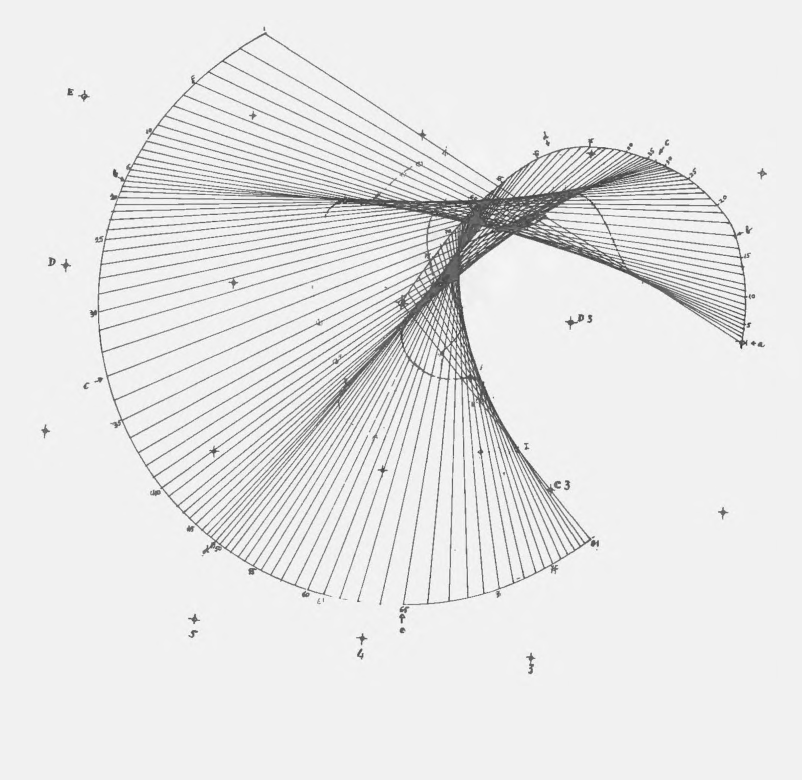
Ragon Dialogue
Xenakis’ text The Cosmic City asks if it is isn’t necessary to opt for an architectural decentralization and a decentralization of cities, or if centralization should not be accepted.
You propose to construct vertical, narrow cities which would reach up to three thousand, indeed even five thousand meters in altitude; therefore, cities not very vast, but entirely in metal: some kind of giant skyscrapers but ones containing a city’s complete morphology. You find that con centration is a vital necessity for humanity, as you say, and that it’s necessary to completely change present urbanist and architectural ideas and replace them by others.
Cosmic City
The idea to realize an architecture where no two sections are the same, on monumental scale. The city is immense but compact, with minimization of ground use. Individualized motor transport is no longer necessary, only high speed elevators and escalators.
Inhabitants will be more directly put in contact with the clouds, and the vast expanses of the sky.
Xenakis proposes several towers in the form of hyperboloids of revolution, stretching up to 5 km in height, not without recalling that of the Assembly of Chandigarh. This set of towers shelters a city of 500 0000 inhabitants, thanks to a system of ventilation and circulation. To live on the Earth vertically, to touch the clouds and to open up to galactic space
Xenakis views densification of human dwellings and relations is a historical necessity. It is necessary today because of the invasion of planetary space by dispersed cities which destroy the environment.
Such a great densification does not mean that I refuse man’s solitude, his right to isolate himself as an individual in this enormous beehive which is today’s city.
Cities must be organized in a vertical manner.
Garden City
The Garden City movement was 20th century urban planning movement promoting satellite communities surrounding a central city, separated by greenbelts.
Forest Hills, and Garden City NY were designed as such.
Man has not known clothing for a very long time. He has worn clothes for only about ten thousand years, no more. Before, he was nude. He later put on individualized, personalized garments. He works from morning to night in places such as we are right now, for example, which have no air and from where he cannot see the light of day.
He touches on a kind of nomadism of architecture (transformation of rooms and houses – probably thinking along the lines of his parametrization).
Xenakis is referred to as a “cold fire.” “I would not like to omit pointing out that, in all of your texts, there is an eulogy to art. Such praise of art is so uncommon and remarkable today, when we hear mostly about the death of art. ”
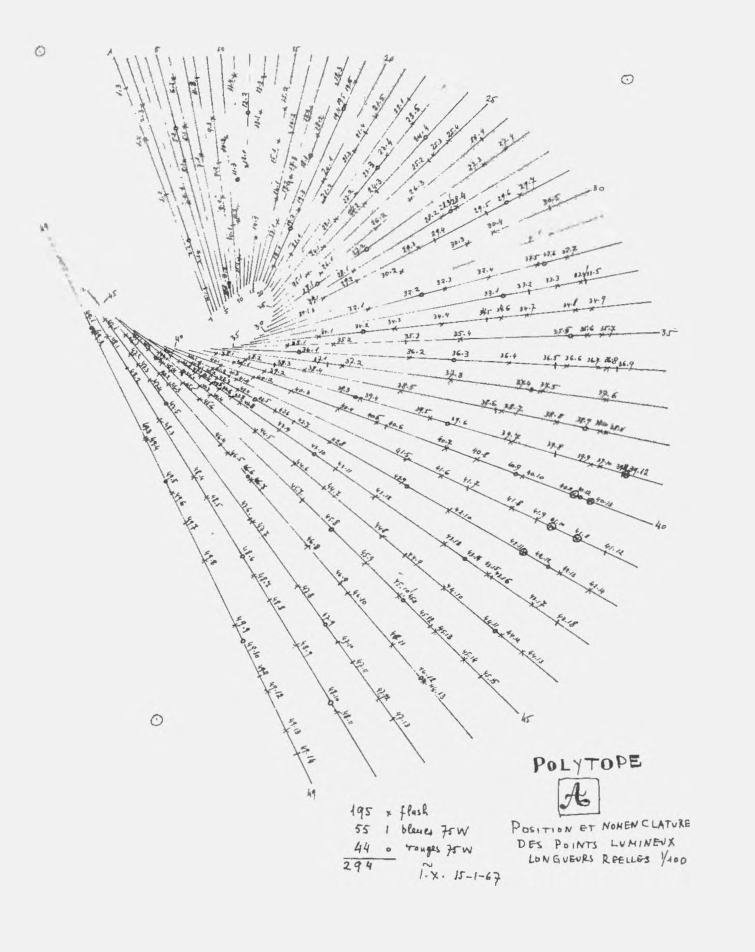
Serres Dialogue
Section on why fugue is an (relative) automaton.
Thought
This format of a sentence above “an (relative) automaton.”
a (word) word2 or an (word) word2
It seems you match the noun, not the parenthetical modifier?
I think that it corresponds more or less to the definition of a scientific automaton which came about in the twenties thanks to Wiener and cybernetics. It can be summarized in the following manner: An automaton is a network of causes and effects, mean ing a temporal chain of events, eventually coupled or multicoupled with certain liberties. An automaton can be closed. It suffices to plug in energy and it works cyclically. It can be relatively open, complete with data entries and external actions, thanks to the help of buttons, for example. Every time new data entries are given, an automaton can produce different results, despite the internal rigor which defines it.
The fact that things can be repeated, experiences or phenomena renewed, offers them a kind of security with regard to time, which, in fact, never repeats itself.
Palindromic: Serres: Yes, when you come along with compositions based on stochastics, that touches upon the problem of time. When composing, what relations do you draw between order and disorder? I know what disorder is because I know how you handle that. But what is order, what is your syntax?
Xenakis: Well, there are several facets. For example, I can say there’s order when there’s symmetry.
Serres says he has won, “so that means we’re going to come back to the question of time. If there is symmetry there can be reversability …”
Xenakis: “No, because there can be order in non-temporal things. That’s why it’s absolutely indispensable to distinguish between what is in and what is outside of time. For example, I’ll take a group of keys on a piano (an elementary case). I then have intervals which repeat themselves, but they are never repeated in time; they’re there, fixed. The piano keys are on a piano which doesn’t move.”
He says the keys, and syntax are outside of time.
Straight Lines
Yes, there’s something absolutely fascinating about a straight line. A ray of sunlight is fascinating in itself. Rays of sunlight can be seen when looked at through clouds. The rays of sun which con verge near the ground are, in reality, parallels. A laser’s beam line is something absolute, the line of a mason’s edge is also absolute. The straight line, therefore, exists in nature. But as an intellectual entity, it’s most fascinating from the point of view of speed, direction, and also continuity. From the point of view of con tinuity, it’s impossible to imagine anything simpler than a straight line. Because once you have a curve, for example, you can imagine the forces which produced it, and there are all sorts of torsions and rich curves, while a straight line is one, without forces, iden tically repeating itself.
Teyssédre Dialogue
He applauds the dissertation not as an erudite research report on some little point, but a profound unity of presented texts that converge on a single theme: the alloy (and not a marriage) of the arts and sciences.
I was very surprised, Xenakis, when you referred to Greek music as being the nutritive humus from which our Western tradition has developed.
“composed dispersion”
Bernard: “I wonder if in your theoretical and compositional works, priority isn’t given to the notion of saturation, in other words, a kind of option or subjective taste for dense, full, and not rarefied sonic spaces.”
Ergodicity discussion.
